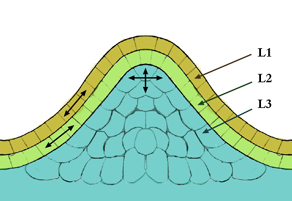Tunica (biology)
Tunica (Biology)
The term "tunica" in biology refers to a layer or coat of tissue that covers or envelops an organ or structure. This concept is particularly significant in the study of plant and animal anatomy, where tunicae (plural of tunica) play crucial roles in protection, structure, and function.
Tunica in Plant Anatomy[edit | edit source]
In plant anatomy, the tunica refers to the outermost layers of cells in the apical meristem, which is the region of growth at the tips of roots and shoots. The tunica is responsible for the surface growth of the plant and is characterized by anticlinal cell divisions, meaning the cells divide perpendicular to the surface of the meristem.
Structure and Function[edit | edit source]
The tunica typically consists of one or more layers of cells:
- L1 Layer: The outermost layer, which gives rise to the epidermis of the plant. It is crucial for the protection of the plant and helps in the formation of the cuticle.
- L2 Layer: The second layer, which contributes to the formation of the cortex and other internal tissues. It is involved in the differentiation of various cell types within the plant.
The tunica-corpus model is a widely accepted model that describes the organization of the apical meristem. The tunica is the outer layer, while the corpus is the inner mass of cells that divide in various planes to contribute to the bulk of the plant.
Tunica in Animal Anatomy[edit | edit source]
In animal anatomy, the term "tunica" is used to describe layers of tissue that cover or line organs and structures. These tunicae are often composed of connective tissue and serve various functions depending on their location and composition.
Examples of Tunicae in Animals[edit | edit source]
- Tunica Albuginea: A dense layer of connective tissue that surrounds certain organs, such as the testes and ovaries. In the testes, the tunica albuginea is a fibrous capsule that protects the organ and helps maintain its shape.
- Tunica Intima: The innermost layer of a blood vessel, composed of endothelial cells. It plays a critical role in vascular health and function, providing a smooth lining for blood flow and regulating vascular tone.
- Tunica Media: The middle layer of a blood vessel, consisting of smooth muscle cells and elastic fibers. It is responsible for the regulation of blood vessel diameter and blood pressure.
- Tunica Externa (Adventitia): The outermost layer of a blood vessel, composed of connective tissue. It provides structural support and protection to the vessel.
Clinical Significance[edit | edit source]
Understanding the structure and function of tunicae is essential in both plant and animal biology. In plants, the tunica is crucial for growth and development, while in animals, the various tunicae are important for organ protection, vascular health, and overall physiological function.
In medical practice, diseases and conditions affecting the tunicae, such as tunica intima thickening in atherosclerosis or tunica albuginea damage in Peyronie's disease, are of significant concern and require careful diagnosis and management.
Also see[edit | edit source]
Transform your life with W8MD's budget GLP1 injections from $125
W8MD offers a medical weight loss program NYC and a clinic to lose weight in Philadelphia. Our W8MD's physician supervised medical weight loss centers in NYC provides expert medical guidance, and offers telemedicine options for convenience.
Why choose W8MD?
- Comprehensive care with FDA-approved weight loss medications including:
- loss injections in NYC both generic and brand names:
- weight loss medications including Phentermine, Qsymia, Diethylpropion etc.
- Accept most insurances for visits or discounted self pay cost.
- Generic weight loss injections starting from just $125.00 for the starting dose
- In person weight loss NYC and telemedicine medical weight loss options in New York city available
- Budget GLP1 weight loss injections in NYC starting from $125.00 biweekly with insurance!
Book Your Appointment
Start your NYC weight loss journey today at our NYC medical weight loss, and Philadelphia medical weight loss Call (718)946-5500 for NY and 215 676 2334 for PA
Search WikiMD
Ad.Tired of being Overweight? Try W8MD's NYC physician weight loss.
Semaglutide (Ozempic / Wegovy and Tirzepatide (Mounjaro / Zepbound) available. Call 718 946 5500.
Advertise on WikiMD
|
WikiMD's Wellness Encyclopedia |
| Let Food Be Thy Medicine Medicine Thy Food - Hippocrates |
Translate this page: - East Asian
中文,
日本,
한국어,
South Asian
हिन्दी,
தமிழ்,
తెలుగు,
Urdu,
ಕನ್ನಡ,
Southeast Asian
Indonesian,
Vietnamese,
Thai,
မြန်မာဘာသာ,
বাংলা
European
español,
Deutsch,
français,
Greek,
português do Brasil,
polski,
română,
русский,
Nederlands,
norsk,
svenska,
suomi,
Italian
Middle Eastern & African
عربى,
Turkish,
Persian,
Hebrew,
Afrikaans,
isiZulu,
Kiswahili,
Other
Bulgarian,
Hungarian,
Czech,
Swedish,
മലയാളം,
मराठी,
ਪੰਜਾਬੀ,
ગુજરાતી,
Portuguese,
Ukrainian
Medical Disclaimer: WikiMD is not a substitute for professional medical advice. The information on WikiMD is provided as an information resource only, may be incorrect, outdated or misleading, and is not to be used or relied on for any diagnostic or treatment purposes. Please consult your health care provider before making any healthcare decisions or for guidance about a specific medical condition. WikiMD expressly disclaims responsibility, and shall have no liability, for any damages, loss, injury, or liability whatsoever suffered as a result of your reliance on the information contained in this site. By visiting this site you agree to the foregoing terms and conditions, which may from time to time be changed or supplemented by WikiMD. If you do not agree to the foregoing terms and conditions, you should not enter or use this site. See full disclaimer.
Credits:Most images are courtesy of Wikimedia commons, and templates, categories Wikipedia, licensed under CC BY SA or similar.
Contributors: Prab R. Tumpati, MD



